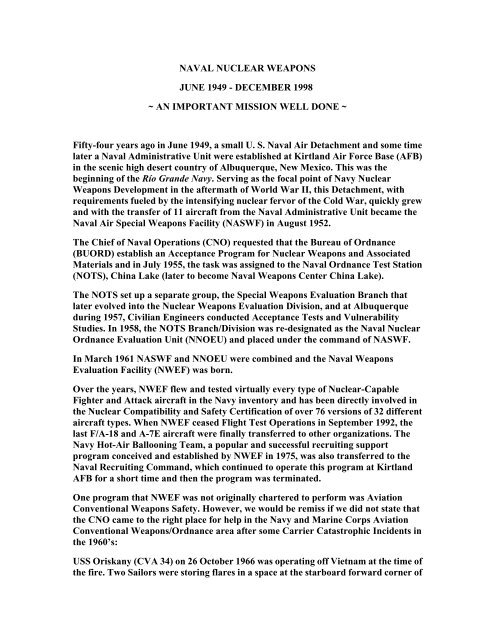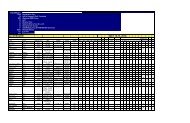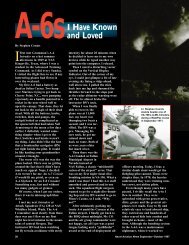NAVAL NUCLEAR WEAPONS JUNE 1949 - DECEMBER 1998 ...
NAVAL NUCLEAR WEAPONS JUNE 1949 - DECEMBER 1998 ...
NAVAL NUCLEAR WEAPONS JUNE 1949 - DECEMBER 1998 ...
You also want an ePaper? Increase the reach of your titles
YUMPU automatically turns print PDFs into web optimized ePapers that Google loves.
the hangar deck. One of the flares lit accidentally, and the Sailor threw it into thelocker and closed the hatch. The locker contained 650 other flares, which quickly lit.The resulting fire caused extensive damage to the ship and killed 44 Sailors. Theentire forward section of the ship from the hangar deck up was gutted;USS Forrestal (CVA 59) on 29 July 1967 was operating off Vietnam at the time of thefire. A Zuni rocket was accidentally launched on deck (due to an electrical problem),hitting a parked A-4, and igniting its drop fuel tank. The fire then spread to otheraircraft, and bombs began to explode on deck. The fire burned for 13 hours, killing134 Sailors and caused the loss of 21 aircraft, some of which were pushed overboardbefore the fire reached them. Seven holes were blown in the flight deck. Repairs tookseven months, requiring complete removal and reconstruction of the aft section of theship down to the hangar deck. This was the worst carrier fire in postwar years;USS Enterprise (CVAN 65) on 14 January 1969 was operating off Hawaii at the time.The sequence of events was similar to the Forrestal fire, starting with a rocketoverheating due to exhaust from an engine starter, was less extensive than thatcaused by deck vehicle and "cooking off". The rocket hit another aircraft, whichignited and touched off a flight deck disaster. The fire was put out within four hours.Damage, although severe, was less extensive than that caused by the Forrestal fire.The nuclear "frigate" USS Bainbridge was one of Enterprise's escorts, and accordingto one of her Sailors she vastly surpassed her rated speed of "30+" knots while racingto the carrier's aid. The next day the frigate escorted the carrier into Pearl Harbor,and the atmosphere was said to be like when the previous USS Enterprise (CV 6)returned to Pearl Harbor the day after the Japanese attack.NWEF developed procedures to safely stow, handle, transport, assemble,disassemble, preload, load, unload, arm, dearm, rearm, and deliver AviationOrdnance-Bombs, Destructors, Torpedoes, Mines, Pyrotechnics, and Missiles-andnumerous other conventional stores from ADSIDs (McNamara’s Electronic Ears) toSonobuoys and Jet Engine Starters. NWEF did a Superb Job. The CNO called on theBEST in 1967 and NWEF PERFORMED until 1993. There have been no CarrierCatastrophic Incidents since the USS Enterprise (CVAN 65) fire on 14 January 1969.The JOB continues in China Lake Today.NWEF also provided important Weapons Evaluation and Safety Support to otherprogram offices and became the mainstay of the Navy's Surface Ship, Submarine andArtillery Launched Nuclear Weapons Programs. Mission tasks involved every facetof Nuclear Weapons Research, Development, Test and Evaluation and covered theentire Stockpile-to-Target Sequence including Logistic Movement, storage, Handling,Loading, Unloading and Delivery.NWEF faithfully and successfully completed these crucial tasks and significantlycontributed to the Navy's FOUR DECADES OF ACCIDENT FREE-<strong>NUCLEAR</strong><strong>WEAPONS</strong> OPERATIONS in spite of the high volume production and fielding anddeployment of Nuclear Delivery Systems during times of fluctuating world tensions.There can be no doubt that the People of NWEF made a Vital Contribution to theDefense of the United States and the Free World.
As an integral supporting element of our Nuclear Capability, NWEF has followed thecourse determined by the Navy's role in Strategic Deterrence. Under several namesand organizational structures, NWEF continually evolved in response to ourNational Policy and the nature of the threat. The changed Global Political climatehas now reduced the need for this type of work and NWEF is once again evolving. Asa result of restructuring, NWEF was Disestablished on 4 June 1993 and theAlbuquerque Detachment of the Naval Air Warfare Center, Weapons Division, wasimmediately established (Stood-Up). NWEF has returned to a similar size andfunction as the first Detachment.Although much reduced, some limited level of Nuclear Deterrence will be needed bythe United States in the coming years and so there is still a small but vital job to bedone. NWEF will live as the Naval Air Warfare Center Detachment Albuquerque(NAWC DET ABQ) to continue to support critical Nuclear Safety Requirements forNavy Systems. NAWC DET ABQ met the challenge and continued this importantwork to support our Nation's Defense and helped to maintain continued World Peace.NAWC DET ABQ provided the critical Nuclear Safety Requirements for NavySystems until <strong>1998</strong>. NAWC DET ABQ was disestablished on 18 December <strong>1998</strong>. Asmall cadre finally closed the Río Grande Navy doors for the last time in March/April1999.




